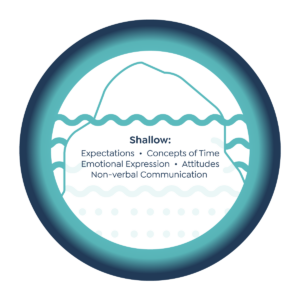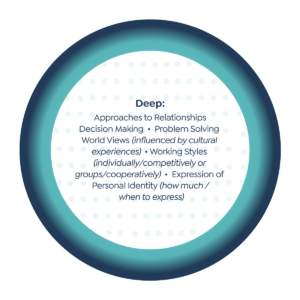 The Hall Iceberg of Culture is a conceptual framework developed by anthropologist Edward T. Hall to illustrate the visible and invisible aspects of culture. According to Hall, culture can be compared to an iceberg, where only a small portion, such as behaviors, customs, and symbols, is visible above the surface. These visible elements are just the tip of the iceberg. The majority of culture lies beneath the surface and includes deeper elements such as beliefs, values, thought patterns, and worldviews.
The Hall Iceberg of Culture is a conceptual framework developed by anthropologist Edward T. Hall to illustrate the visible and invisible aspects of culture. According to Hall, culture can be compared to an iceberg, where only a small portion, such as behaviors, customs, and symbols, is visible above the surface. These visible elements are just the tip of the iceberg. The majority of culture lies beneath the surface and includes deeper elements such as beliefs, values, thought patterns, and worldviews.
This submerged part of the iceberg represents the core assumptions and implicit understandings that shape how individuals within a culture perceive and interact with the world. Hall’s Iceberg Model of Culture emphasizes the importance of understanding these deeper, less visible aspects to comprehend a culture fully. It highlights that superficial observations are insufficient for a complete cultural understanding and encourages a deeper exploration of the underlying factors that influence cultural behavior and attitudes. This model is particularly useful in cross-cultural communication and education, as it promotes awareness and sensitivity to the complexities of cultural dynamics.
The Hall Iceberg of Culture model explores culture through two primary levels: the visible and the invisible. These levels help in understanding how cultural elements manifest in society and influence behavior and thought processes.
Visible Level
Edward T. Hall’s Iceberg Model of Culture is a framework that categorizes cultural elements into three levels: surface culture, shallow culture, and deep culture. Each level represents different aspects of culture that vary in visibility and influence on behavior and perceptions.
 Surface Culture
Surface Culture
Visible and Explicit Elements
- Characteristics: This level includes the visible and tangible aspects of culture that are easily observed and identified.
- Examples: Language, dress, food, customs, art, music, and observable behaviors.
- Significance: These elements are often the first things noticed when encountering a new culture. They are explicit and easily understood but represent only a small part of the entire cultural system.
Invisible Level
 Shallow Culture
Shallow Culture
Unspoken Rules and Social Norms
- Characteristics: This level consists of norms and rules that are not immediately visible but are still generally known and shared within a cultural group.
- Examples: Concepts of personal space, non-verbal communication, etiquette, and social rituals.
- Significance: These elements govern social interactions and can cause misunderstandings if not recognized. They require a deeper understanding to navigate effectively in a different cultural context.
These elements are akin to the tip of the iceberg—visible and easily accessible but only a small part of the whole.
 Deep Culture
Deep Culture
Implicit Beliefs and Worldviews
- Characteristics: This level includes the fundamental beliefs, values, thought patterns, and worldviews that are deeply embedded within a culture. They are often unconscious and taken for granted by members of the culture.
- Examples: Core values, religious beliefs, worldviews, attitudes towards authority and relationships, concepts of time, and underlying assumptions about life.
- Significance: These elements are the most influential in shaping behavior and perceptions but are the hardest to observe and understand. They require significant effort to uncover and comprehend, as they are deeply rooted in the cultural psyche.
Understanding these three levels of culture is crucial for effective cross-cultural communication and interaction. It helps individuals move beyond superficial observations to grasp the underlying factors that shape cultural behavior and attitudes, leading to more meaningful and respectful intercultural engagements.
Integration and Interaction
The visible and invisible levels of culture are interconnected and influence each other. The visible aspects provide a glimpse into the deeper cultural elements, while the invisible aspects shape how the visible ones are expressed and interpreted. Understanding both levels is crucial for a comprehensive understanding of any culture, as it reveals the full complexity and richness of cultural identity.
The Iceberg of Culture model emphasizes that to truly understand a culture, one must look beyond the surface and explore the deeper, often hidden, elements that drive and shape observable behaviors and practices. This deeper exploration fosters more meaningful cross-cultural interactions and insights and nurtures meaningful, asset-based and healthy connection.
Trust Matters
Sharing stories and narratives aligned with the layers of the Iceberg of Culture requires and nurtures relational trust in several ways:
The Importance of Relational Trust
- Vulnerability: Sharing personal stories, especially those that touch on deep-seated cultural beliefs and values, involves a level of vulnerability. Trust is needed for individuals to feel safe enough to reveal these intimate aspects of their identity.
- Empathy and Understanding: When discussing cultural elements beneath the surface, such as beliefs and values, there is a need for the listener to be empathetic and understanding. Trust ensures that the speaker feels their perspectives will be respected and not judged.
- Reciprocity: For storytelling to be effective, it often involves a reciprocal exchange of narratives. This mutual sharing builds and requires trust, as both parties need to feel comfortable revealing and listening to personal stories.
As individuals reveal and understand the deeper, often unseen aspects of their cultural identity, relational trust is both a prerequisite and a product of this intimate exchange.
Nurturing Relational Trust
- Creating Connection: Storytelling allows individuals to connect on a deeper level by sharing experiences and emotions. This connection helps build trust as people find common ground and understanding through shared human experiences.
- Authenticity: When individuals share authentic stories about their cultural background and personal experiences, it fosters an environment of honesty and openness. This authenticity is foundational to building trust.
- Mutual Respect: As stories are shared, listeners who practice active listening demonstrate respect for the speaker’s experiences and perspectives. This respect reinforces relational trust.
- Deeper Understanding: Narratives that delve into the layers of culture provide insight into the speaker’s worldview and values. This deeper understanding helps dismantle stereotypes and prejudices, fostering trust and respect.
- Empowerment: Sharing and listening to stories can be empowering for both the speaker and the listener. It validates the speaker’s experiences and allows the listener to gain new perspectives, building a trusting and collaborative relationship.
- Conflict Resolution: Storytelling can be a powerful tool in resolving conflicts. By understanding the deeper cultural contexts that influence behavior and beliefs, individuals can navigate misunderstandings and find common ground, reinforcing trust.
The process of sharing stories aligned with the Iceberg of Culture not only necessitates an environment of trust but also actively cultivates it. As individuals reveal and understand the deeper, often unseen aspects of their cultural identity, relational trust is both a prerequisite and a product of this intimate exchange. This storytelling process requires active listening.
The narratives that emerge from this cultural iceberg are not merely stories; they are the lifeblood of our identities, shaping our perceptions, interactions, and collective consciousness.
Active Listening
Active listening is a critical skill in effective communication, particularly when discussing complex and sensitive topics such as those related to the Iceberg of Culture. Key attributes of active listening include:
- Full Attention: Giving the speaker your undivided attention without distractions shows respect and ensures you fully understand their message.
- Non-Verbal Cues: Maintaining eye contact, nodding, and using facial expressions to show engagement and understanding.
- Reflective Listening: Paraphrasing or summarizing what the speaker has said to confirm understanding and show that you are processing their words.
- Empathy: Demonstrating an understanding of the speaker’s feelings and perspectives, which fosters trust and openness.
- Open-Ended Questions: Asking questions that encourage the speaker to elaborate and provide more depth, rather than yes/no questions.
- Avoiding Interruptions: Allowing the speaker to finish their thoughts without interjecting, which shows respect and ensures you fully capture their message.
- Feedback: Providing thoughtful responses or clarifications that indicate you are engaged and interested in the conversation.
These attributes are particularly important when discussing stories related to the Iceberg of Culture because much of what is significant lies beneath the surface. Active listening helps uncover these deeper cultural elements by creating a safe space for individuals to share their underlying beliefs, values, and thought patterns. This deepens understanding and fosters more meaningful and respectful cross-cultural interactions.
By truly listening, we can move beyond superficial observations and engage with the rich, complex fabric of another culture, promoting empathy and reducing misunderstandings.
Fostering Harmony
Understanding the iceberg of culture, with its visible tip and vast, unseen depths, illuminates the profound complexity of our shared humanity. The narratives that emerge from this cultural iceberg are not merely stories; they are the lifeblood of our identities, shaping our perceptions, interactions, and collective consciousness. As we delve beneath the surface, we uncover rich, diverse perspectives that challenge us to rethink our assumptions and embrace a more inclusive worldview. By recognizing and honoring these hidden narratives, we pave the way for deeper empathy and stronger connections, fostering a world where every voice is heard and valued.
Exploring the depths of culture is an exploration of humanity’s essence—an enriching experience that brings us closer together and fosters a more harmonious and empathetic global community.
Sources:
Archibald, J. (2008). Indigenous Storywork: Educating the Heart, Mind, Body, and Spirit. UBC Press.
Brownell, J. (2012). Listening: Attitudes, Principles, and Skills (5th ed.). Pearson Education.
Hall, E. T. (1976). Beyond Culture. Garden City, NY: Anchor Press.
Kovach, M. (2009). Indigenous Methodologies: Characteristics, Conversations, and Contexts. University of Toronto Press.
Rogers, C. R., & Farson, R. E. (1987). Active Listening. In R. G. Newman, M. A. Danziger, & M. Cohen (Eds.), Communicating in Business Today (pp. 19-26). D.C. Heath and Company.
Ting-Toomey, S. (1999). Communicating Across Cultures. New York, NY: The Guilford Press.



